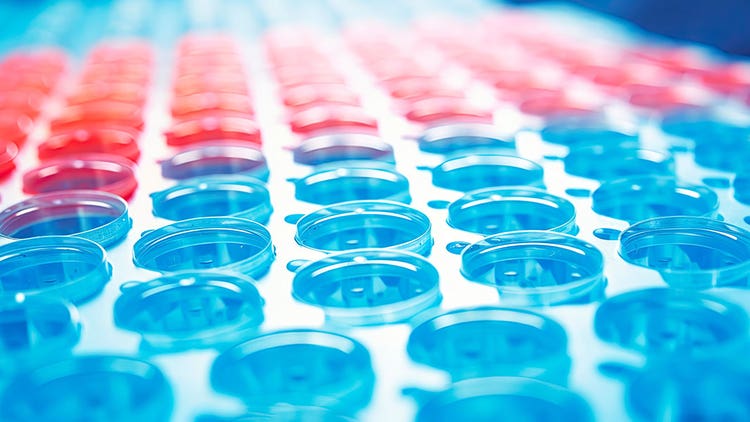What is ELISA?
The enzyme-linked immunosorbent assay (ELISA) is a biochemical analytical technique to quantify and characterize various substances such as peptides, proteins, antibodies and hormones in a sample mixture. A crucial aspect of conducting an ELISA involves achieving a specific and accurate interaction between the capture / target antibody and antigen.
ELISA plays a crucial role in the life sciences by enabling precise detection and measurement of analytes facilitating clinical diagnostics, disease monitoring and drug development.
Principles of ELISA
Antigen-antibody interaction in ELISA
The underlying principle of ELISA relies on the interaction between antigens or antibodies and their specific substrate. This interaction enables detection and measurement of desired molecules. ELISA utilizes a capture antigen or antibody that is immobilized on a solid surface and mixed with enzyme-linked target analytes that bind the capture molecule. The result is an observable signal that can be interpreted to quantify concentration of the desired molecule.
Types of ELISAs commonly used in Life Sciences
- Direct ELISA: The antigen or sample is directly attached to the microplate and a conjugated detection antibody binds to the target. Introducing a substrate produces a signal proportional to the amount of the analyte in the sample.
- Indirect ELISA: The antigen is immobilized on a plate and exposed to an unconjugated primary detection antibody that specifically binds to the antigen, followed by the introduction of a conjugated secondary antibody that recognizes the primary antibody. Finally, substrate addition generates a signal proportional to the bound antigen.
- Sandwich ELISA: An immobilized capture antibody attached to a microplate binds the target molecule followed by the introduction of a conjugated detection antibody that binds to a separate epitope on the target molecule. Substrate addition generates a signal proportional to the analyte quantity.
- Competitive ELISA: A capture antibody is coated onto a microplate. Then a conjugated antigen is used to compete with the antigen in the sample for binding to the capture antibody. The quantity of protein in the sample affects the binding of the conjugated antigen to the capture antibody, resulting in a substrate-generated signal that is inversely proportional to the protein's quantity in the sample.
See how Danaher Life Sciences can help
Application of ELISA
- Protein detection and quantification: ELISA is used to detect and quantify proteins in samples, like measuring cytokine levels in serum to assess immune response. ELISA can also confirm the presence of a specific protein biomarkers in blood samples that can be used for early detection of a disease, such as prostate-specific antigen (PSA) for prostate cancer screening.
- Antibody detection and characterization: ELISA allows for the screening, profiling, identification and characterization of binding properties of antibodies in a single assay. It involves screening and selecting specific monoclonal antibody-producing hybridoma cells and subsequently purifying the antibodies for various applications.
- Disease research and diagnostics: In diagnostics, ELISA allows the accurate identification and measurement of specific antigens or antibodies associated with the pathogens responsible for infectious diseases. It helps detect and quantify autoantibodies and biomarkers, aiding diagnosis, monitoring and understanding of these conditions.
ELISA is also used to detect and quantify specific biomarkers that aid in the early detection, diagnosis and monitoring of various cancer types.
- Drug discovery and development: In pharmacokinetics and pharmacodynamics studies, ELISA is used to measure and analyze drug concentrations and their effects on target molecules, facilitating the understanding of drug metabolism and therapeutic efficacy. The detection and characterization of specific target molecules by ELISA aid in developing and assessing potential therapeutic interventions.
Advanced Techniques and Variations of ELISA
- Multiplex ELISA: It allows the simultaneous detection of multiple analytes in a single sample, increasing efficiency and throughput in life sciences research.
- Phage display: It utilizes genetically engineered phages to present target antigens, enabling screening and selecting specific binding antibodies.
- Reverse ELISA: It involves immobilizing antibodies and detecting the presence of their corresponding antigens, enabling efficient antibody detection and quantification.
- Cell-based ELISA: It measures cellular responses, such as cytokine release or protein expression, providing insights into cellular behavior and signaling pathways.
- Chemiluminescent and fluorescent ELISA: These employ light-emitting or fluorescent molecules for signal detection, offering enhanced sensitivity and quantification capabilities in immunoassays.
Advantages and Limitations of ELISA
Advantages
- High sensitivity and specificity - ELISA can detect low concentrations of target molecules with high accuracy, ensuring reliable results.
- Wide range of applications - ELISA is used in clinical diagnostics, drug discovery, environmental monitoring and food safety testing.
- Quantitative and qualitative analysis - ELISA enables quantitative measurement of analytes, allowing precise concentration determination and qualitative analysis for the presence or absence of specific targets.
- Relatively easy and cost-effective - ELISA has straightforward protocols and relatively low equipment costs, making it accessible to many researchers and laboratories.
Limitations
- False positives and false negatives - ELISA can yield false positives or false negatives due to assay conditions or sample characteristics.
- Limited dynamic range - It has a limited quantification range, which can result in saturation or detection limitations, leading to inaccurate measurements.
- Cross-reactivity and interference – Unintended binding can impact assay specificity and accuracy.
Recent Developments and Future Directions of ELISA
Recent developments improve assay sensitivity and detection limits by enhancing detection methods through amplification and signal enhancement strategies. Integrating with microfluidics and lab-on-a-chip technologies enables miniaturization, faster analysis and reduced sample/reagent consumption for increased portability. Automated ELISA processes enhance efficiency, reduce errors and enable high-throughput screening through automated sample handling, reagent dispensing and data analysis. Using ELISA for personalized medicine and precision diagnostics can help identify and measure specific biomarkers for individualized treatment and accurate disease diagnosis.
See how Danaher Life Sciences can help
Enzyme-Linked Immunosorbent Assay (ELISA)
